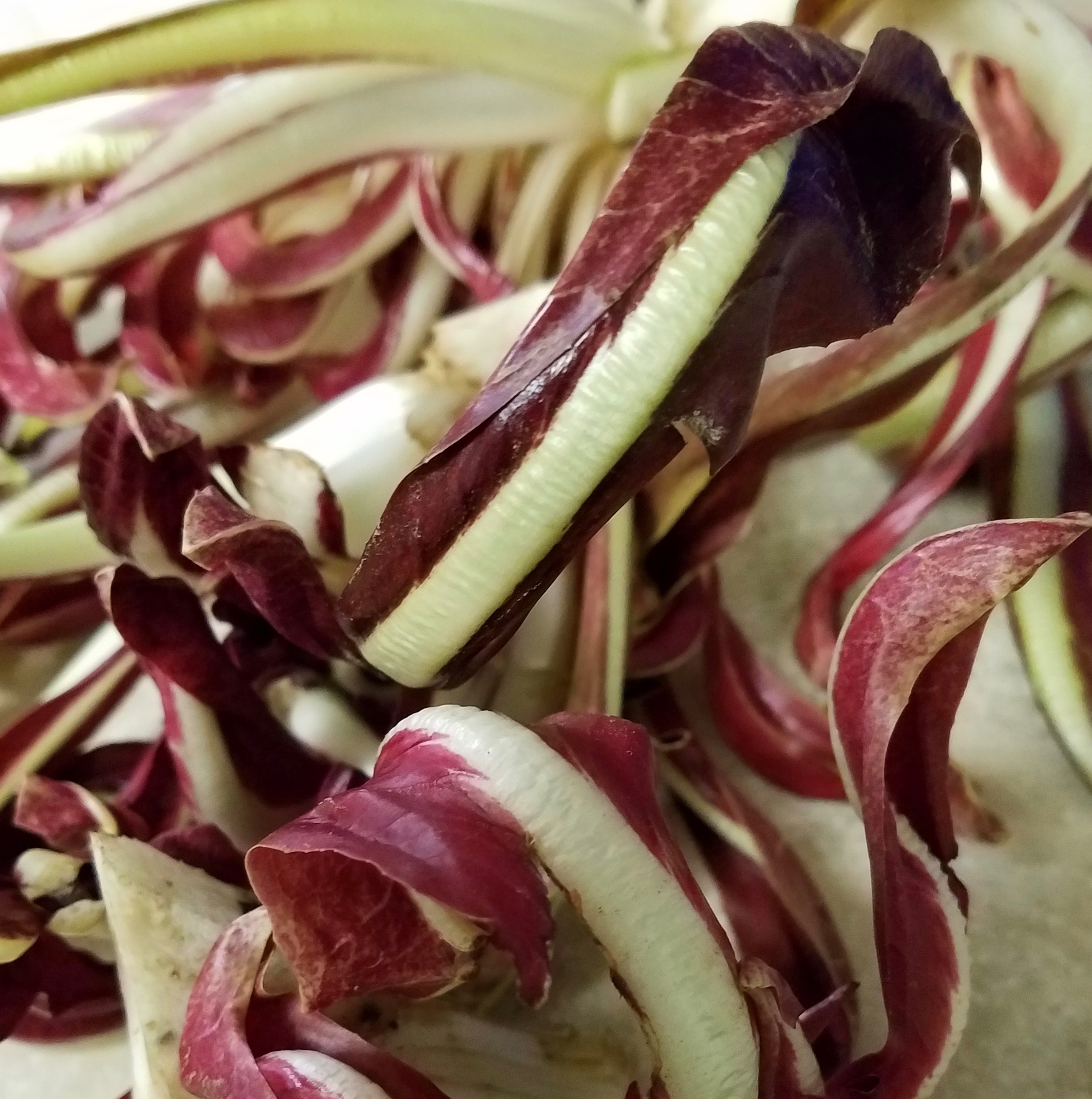
A sea of greens (from left to right): Pak Choi, Tat Soi, Mustard Greens, Broccoli Raab, Collards, Swiss Chard, Kale, Spinach, Arugula
Do you feel stumped by the sea of greens available to you at the CSA share? Don’t worry, we’re here to sort it out.
First of all, a few things about what is (and isn’t) in the photo you see above. The photo contains all of what are generally considered to be “dark, leafy greens” that the farm currently offers (at least as of the third week of September). Not included are lettuce (which is not generally considered a “dark” leafy green because it lacks a lot of the nutrients that are generally available in that category of food) and radicchio (which does have a lot of nutrition but actually has white and purple leaves). Radicchio is not yet ready for harvest, so keep an eye out for it in the coming weeks. Here’s a photo:
As you become a more experienced cook, at some point you will probably realize that, if a recipe calls for a specific type of dark leafy green, you can usually substitute a different dark leafy green, depending on what you have in your fridge. The flavors are not exactly the same (especially when eaten raw), but if a recipe calls for kale and you only have chard (for instance), you can easily substitute one for the other. In general, greens are slightly bitter when eaten raw; the bitterness fades when cooked.
Let’s go through the list so you can have a better idea about each one.
- Pak choi (also called bok choy) and tat soi are often used in Asian cooking. Pak choi has a thicker, juicier stem, but other than that the flavors are fairly similar. Both are terrific in stir-fries or when sauteed.
- Mustard greens, arugula, and radicchio are all rather spicy when eaten raw, but the spiciness dies down when cooked. Arugula is commonly used in salads, though mustard greens can be a little spicy for many people. Radicchio is both bitter and spicy; it makes an attractive addition to salad, or it can be sauteed to mellow the flavor.
- Broccoli raab (also called broccoli rabe or rapini) is commonly used in Italian food; in contrast to the previously-mentioned greens, it can actually become slightly spicy when cooked, though it is not spicy when eaten raw.
- Collards are staple of southern cooking, almost always slow-cooked with ham or bacon. A traditional meal of collards, black eyed peas, and cornbread is often served on New Year’s Day in the south; the black eyed peas represent good luck, and the cornbread and collards represent wealth (gold and dollar bills respectively).
- Chard comes in several varieties; the type we grow at the Hampshire College Farm is called Swiss Chard, which has pretty, multi-colored stems. Chard is an excellent, all-purpose green and its stems provide some visual interest in a mostly green world.
- Kale is possibly the most iconic vegetable of New England, perhaps because of its impressive abilities to survive cold conditions; in fact, it gets sweeter after the first frost. Kale can be put to many uses, including smoothies, kale chips (recipe below), salads, soups, stir fries, etc.
- Spinach is probably familiar to most of you, as it is a very common ingredient in salads, smoothies, and in many cooked forms. Some people find the texture of raw spinach a little challenging, but otherwise it is a very popular green.
Be aware that kale and collards hold their structure when cooked; all the others shrink dramatically when exposed to heat. If greens are taking up a lot of space in your fridge, go ahead and cook them sooner rather than later – you’ll be surprised at how quickly they disappear.
Sauteed greens (vegan, opt. gluten-free)
by Reeve Gutsell
This is a very basic, go-to recipe for sauteed greens – as much a jumping-off point as anything. Feel free to add or subtract any flavorings you would like, in accordance with the style of your main dish. You can also add other vegetables – mushrooms in particular have an earthy flavor that goes well with greens. Beets also go well with greens (in fact, beets have their own delicious greens, though the farm usually removes them first.) You can use almost any dark leafy greens, in any combination, for this recipe.
Prep time: 5 min
Cook time: 5 min
Serves 4-6
Ingredients
As many greens as will reasonably fit in the frying pan, chopped into bite-sized pieces
1 med onion, chopped (if you have a small pan, only use 1/2 onion)
4-5 cloves of garlic, minced
3 tbs. olive oil
sesame oil – a few dashes for flavor
soy sauce or tamari – a few dashes for flavor
salt and pepper to taste
Directions
Sautee the chopped onions over medium heat in the olive oil until they get soft and translucent, about 3 minutes. Add the minced garlic and sautee for another 30 seconds or so, until the garlic starts turning brown. Add the greens, sesame oil, soy sauce, salt, and pepper, and sautee until the greens are cooked through, about a minute or two more. Serve hot.
Kale chips (vegan, gluten-free)
by Reeve Gutsell
This is a very simple recipe that makes a surprisingly tasty and nutritious snack. The trick is to thoroughly coat each piece of kale in olive oil – don’t just drizzle it on and hope for the best.
Prep time: 2 minutes, plus time to heat the oven
Cook time: 20 minutes
Ingredients
About 1/2 bunch of kale, or as much as will fit onto a baking tray after being chopped into bite-sized pieces
olive oil
salt
Directions
Preheat the oven to 350 degree F. Chop the kale into bite-sized pieces. Thoroughly coat each individual piece in olive oil, making sure to cover the front and back. (Yes, your hands are going to get coated in olive oil as well, so have a paper towel nearby.) Lightly salt the kale chips.
Bake for about 10 minutes, then flip the kale chips and bake for another 10 minutes until brown and crispy. These are delicious served hot right out of the oven. These will most likely get gobbled up, but if there are any leftovers just make sure they are completely cooled before you store them or they will get soggy in the container.
Enjoy!




Another great things to do with dark, leafy greens is make pesto. It is super simple usually, especially if you have a blender. But you don’t even need that here is a link to a pesto recipe that does not require a blender or food processor https://georgiapellegrini.com/2019/02/08/food-drink/how-to-make-pesto-without-a-food-processor/.
You don’t need to add cheese, it’s for flavor. So you can leave that out and make it Vegan (I add a little extra salt when I do that). Also, pine nuts are EXPENSIVE. You can actually use any nuts you have around, I recommend walnuts or almonds (usually not peanuts or anything with it’s own strong taste). BEST OF ALL you can freeze pesto. I make little packets of it in foil, 2-3 tablespoons, then just take it out when I need it and add it to a bowl of pasta, my soup, whatever. Happy Cooking !
Great idea, Arabel! Do you mean adding dark leafy greens to the basil, or replacing the basil altogether? I often add a little spinach to my pesto, which helps keep it a nice green color. (Crushed basil can turn a not-super-attractive brownish-gray color when exposed to air, so adding something green like spinach to the mix helps keep the pesto looking nice.)
Reeve,
Excellent point on the crushed basil, I think when you put it into the bag you might try to remove as much of the air as possible before you gently crush it. Basil, or whatever green you use, should be finely minced already so this is just a final process to get it a little finer and mix everything.
I usually swap out equal amounts of a green for basil, so a pesto recipe that calls for 4 cups of basil I would use 4 cups of kale. With basil and spinach they have a high water content, not true with something like kale which you pointed out so I usually add a little extra olive oil a the end. Now I’m going to eat a big bowl of Kale Pesto.
Cheers,
Arabel
Thanks for clarifying, Arabel – sounds delicious! Looking forward to trying some new forms of pesto!
Reeve